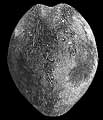The Echinoid Directory
Contributed by Andreas Kroh, August 2010
Araeolampas Serafy, 1974, p. 43
| Diagnostic Features |
|
|---|---|
| Distribution | Recent; Circumtropical. |
| Name gender | feminine |
| Type | Homolampas fulva A. Agassiz, 1879. by original designation. |
| Species Included |
|
| Classification and/or Status | Spatangoida, Micrasterina, Loveniidae or Maretiidae. |
| Remarks | Araeolampas differs from Homolampas by the presence of a peripetalous fasciole, crenulate primary tubercles, presence of enlarged tubercles in adapical interambulacrum 5, and four genital pores (usually 3 in Homolampas). Furthermore Araeolampas in contrast to Homolampas is reported to lack globiferous pedicellariae. Serafy, D. K. 1974. A new heart-urchin, Araeolampas atlantica, new genus, new species, from the North Atlantic and notes on the closely related Homolampas. Proceedings of the Biological Society of Washington 87, 41-48. |

